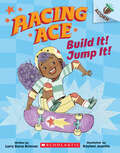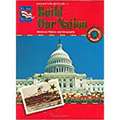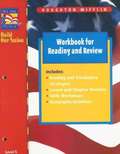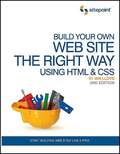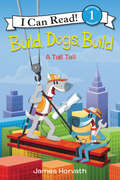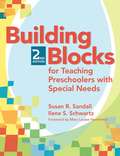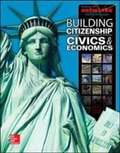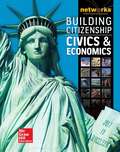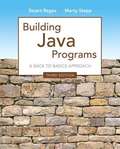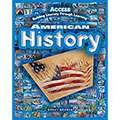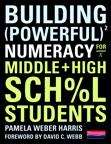- Table View
- List View
Build It! Jump It!: An Acorn Book (Racing Ace)
by Larry Dane BrimnerAce builds a cool skateboard and learns how to skate in this fast-paced, STEM-themed early reader!Pick a book. Grow a Reader!This series is part of Scholastic's early reader line, Acorn, aimed at children who are learning to read. With easy-to-read text, a short-story format, plenty of humor, and full-color artwork on every page, these books will boost reading confidence and fluency. Acorn books plant a love of reading and help readers grow!Ace works hard to build a skateboard. She tightens every nut and bolt -- and adds a cool sticker. Then, Ace is ready to skate. But Ace goes too fast and falls down! She will have to try again. Will Ace ever be able to rocket up the ramp?With Larry Dane Brimner's simple text and Kaylani Juanita's full-color artwork on every page, this action-packed book is perfect for new readers!
Build Our Nation
by Catherine Clinton Sarah Bednarz Michael Hartoonian Arthur Hernandez Patricia L. Marshall Pat NickellUnited States history textbook.
Build Our Nation
by Catherine Clinton Sarah Bednarz Michael Hartoonian Arthur Hernandez Patricia L. Marshall Pat NickellHistory textbook for teens.
Build Our Nation: We the People
by Catherine Clinton Sarah Bednarz Michael Hartoonian Arthur Hernandez Patricia L. Marshall Pat NickellA great history book about United States for grade 3-5 students.
Build Our Nation: Workbook for Reading and Review
by Houghton Mifflin Company StaffLearn about important words in the history and geography of the United States.
Build Your Own Library
by Lori O'Dea Claire BooherTired of staring at that big pile of books? Read to find out how to turn the pile into a library!
Build Your Own Web Site the Right Way Using HTML & CSS (2nd Edition)
by Ian LloydBuild Your Own Website The Right Way Using HTML & CSS, 2nd Edition teaches web development from scratch, without assuming any previous knowledge of HTML, CSS or web development techniques. This book introduces you to HTML and CSS as you follow along with the author, step-by-step, to build a fully functional web site from the ground up. However, unlike countless other "learn web design" books, this title concentrates on modern, best-practice techniques from the very beginning, which means you'll get it right the first time. The web sites you'll build will: Look good on a PC, Mac or Linux computer Render correctly whether your visitors are using Internet Explorer, Firefox, Opera, or Safari Use web standards so your sites will be fast loading and easy to maintain Be accessible to disabled users who use screen readers to browse the Web By the end of the book, you'll be equipped with enough knowledge to set out on your first projects as a professional web developer, or you can simply use the knowledge you've gained to create attractive, functional, usable and accessible sites for personal use.
Build, Dogs, Build: A Tall Tail (I Can Read Level 1)
by James HorvathBeginning readers will love this I Can Read adventure starring a doggy construction crew, gently adapted from James Horvath’s popular picture book of the same title. Top dog Duke and his crew of construction-worker dogs are ready to knock down an old building and build up a shiny new one. With cranes, bulldozers, dump trucks, and cement mixers all on the job, these busy dogs have a lot to do. Will they finish the new building in time?Build, Dogs, Build is a Level One I Can Read book, which means it’s perfect for children learning to sound out words and sentences.
Building Blocks For Teaching Preschoolers With Special Needs (Second Edition)
by Samuel L. Odom Susan R. Sandall Ilene S. Schwartz Gail E. Joseph Eva M. Horn Mary Louise HemmeterUpdated for today's educators--especially those new to inclusion--the second edition of this bestselling guide is the lifeline preschool teachers need to fully include children with disabilities in their classrooms. Easy to use with any existing curriculum, including Creative Curriculum and HighScope, Building Blocks gives educators three types of practical, research-based inclusion strategies that promote progress in critical areas like behavior, emergent literacy, and peer relationships. A must for professional development, this revised edition helps teachers thrive in the era of accountability with NEW material that reflects the six years of changes in early education since the first edition. Teachers will discover how the Building Blocks approach aligns with OSEP outcomes to help teachers meet the federal requirements for special education learn everything they need to know about evidence-based practice and how to apply it in their classrooms. Through clear and instructive vignettes woven throughout the book, teachers will also meet four young children from diverse backgrounds and learn from their teachers' examples of successful interventions. A perfect training tool for teachers and an ideal textbook for college and university courses, this revised bestseller will help today's preschool educators start all their students on the road to lasting school success. Promote inclusion and improve child outcomes through curriculum modifications that allow all children to participate embedded learning opportunities used in typical classroom activities child-focused instructional strategies that help students with individual learning objectives
Building Citizenship: Civics & Economics
by Patrick Clayton Remy SaffellPrepare your students for citizenship in today's world with the first fully integrated print and digital learning experience for civics and economics. Focus on the Essential Questions with content built around Enduring Understanding and the National Civics and Economics Standards Make concepts real and relevant with The Story Matters chapter openers, Teen Citizens in Action, Landmark Supreme Court Cases and service learning activities Maximize comprehension with built-in reading strategies, and vocabulary support Build critical thinking skills with You Decide, Being an Active Citizen, Why It Matters, and 21st Century Skill Activities
Building Citizenship: Civics & Economics
by John J. Patrick Richard C. Remy Gary E. Clayton David C. SaffellBuilding Citizenship: Civics & Economics engages students in principles that serve as the foundation of our government and economy while emphasizing real-life citizenship and personal financial literacy. This practical, interactive Civics and Economics curriculum includes a strong emphasis on critical thinking, project-based learning, document-based analysis and questions, and the development of close reading skills. Connect to core civics and economics content with an accessible, student-friendly text aligned to the Understanding by Design® instructional approach
Building Citizenship: Civics & Economics
by John J. Patrick Richard C. Remy David C. SaffellNIMAC-sourced textbook
Building Citizenship: Civics & Economics
by John J. Patrick Richard C. Remy David C. SaffellNIMAC-sourced textbook
Building Citizenship: Civics & Economics
by John J. Patrick Richard C. Remy David C. SaffellNIMAC-sourced textbook
Building Citizenship: Civics and Economics
by McGraw-Hill GlencoePrepare your students for citizenship in today's world with the first fully integrated print and digital learning experience for civics and economics. Focus on the Essential Questions with content built around Enduring Understanding and the National Civics and Economics Standards Make concepts real and relevant with The Story Matters chapter openers, Teen Citizens in Action, Landmark Supreme Court Cases and service learning activities Maximize comprehension with built-in reading strategies, and vocabulary support Build critical thinking skills with You Decide, Being an Active Citizen, Why It Matters, and 21st Century Skill Activities.
Building English Skills (Brown Level)
by Susan Duffy Schaffrath Frances Freeman Paden Sandra D. Wittenbrink3rd grade textbook
Building English Skills 9th Grade (Orange Level)
by Staff of The Writing Improvement ProjectComposition and Grammar textbook
Building English Skills, Aqua Level
by Kathleen L. Bell Susan Duffy Schaffrath Frances Freeman PadenEvery day you hear or read new words. How can you find out what they mean? One way is to look them up in a dictionary. Another way is to look for clues to the meaning of a new word. When you are reading, these clues may be right in front of you.
Building Java Programs: A Back To Basics Approach
by Stuart Reges Marty SteppBuilding Java Programs: A Back to Basics Approach, Third Edition, introduces novice programmers to basic constructs and common pitfalls by emphasizing the essentials of procedural programming, problem solving, and algorithmic reasoning. By using objects early to solve interesting problems and defining objects later in the course, Building Java Programs develops programming knowledge for a broad audience. NEW! This edition is available with MyProgrammingLab, an innovative online homework and assessment tool. Through the power of practice and immediate personalized feedback, MyProgrammingLab helps students fully grasp the logic, semantics, and syntax of programming. Note: If you are purchasing the standalone text or electronic version, MyProgrammingLab does not come automatically packaged with the text. To purchase MyProgrammingLab, please visit: myprogramminglab. com or you can purchase a package of the physical text + MyProgrammingLab by searching the Pearson Higher Education web site. MyProgrammingLab is not a self-paced technology and should only be purchased when required by an instructor.
Building Life Skills
by Louise A. Liddell Yvonne S. GentzlerBuilding Life Skills gives the tools you need to manage your life and helps you develop skills throughout your life. It contains eight parts and each part helps you develop different skills to build a satisfying life now and in the future. They help exploring relationships, managing time, understanding children, improving health and nutrition, selecting and preparing a variety of foods, caring for clothes, caring for home, improving leadership skills and career possibilities.
Building Literacy Through Learning: American History
by Great SourceActivity Journal for building literacy through learning American History Grades 6-8.
Building Permanent Mathematical Understanding (Fifth Grade)
by Pat JonesA grade five mathematics book.
Building Powerful Numeracy For Middle And High School Students
by David Webb Pamela Weber HarrisSolid research at the elementary level shows how to help all students become mathematically proficient by redefining what it means to compute with number sense. Pam Harris has spent the past ten years scrutinizing the research and using the resulting reform materials with teachers and students, seeing what works and what doesn't work, always with an eye to success in higher math. This book brings these insights to the secondary world, with an emphasis on one powerful goal: building numeracy. Developing numeracy in today's middle and high school students is reflective of the Common Core State Standards mission to build "the skills that our young people need for success in college and careers. " (CCSS 2010) Numeracy is more than the ability to do basic arithmetic. At its heart, numeracy is the ability to use mathematical relationships to reason with numbers and numerical concepts, to think through the math logically, to have a repertoire of strategies to solve problems, and to be able to apply the logic outside of classrooms. How can we build powerful numeracy in middle and secondary students? Harris's approach emphasizes two big ideas: Teach the importance of representation. The representation of student strategies on models such as the open number line, the open array, and the ratio table promote discussion on relationships rather than procedures Teach with problem strings. Introduced by Catherine Twomey Fosnot and her colleagues in the Young Mathematicians at Work series, problem strings are purposefully designed sequences of related problems that help students construct numerical relationships. They encourage students to look to the numbers first before choosing a strategy, nudging them toward efficient, sophisticated strategies for computation. Understanding numerical relationships gives students the freedom to choose a strategy, rather than being stuck with only one way to solve a problem. Using the strings and activities in this book can empower your students to reason through problems and seek to find clever solutions. They'll become more naturally inclined to use the strategies that make sense to them. Students become engaged, willing to think, and more confident in their justifications. When we give secondary students this numerical power, we also help them learn higher mathematics with more confidence and more success.
